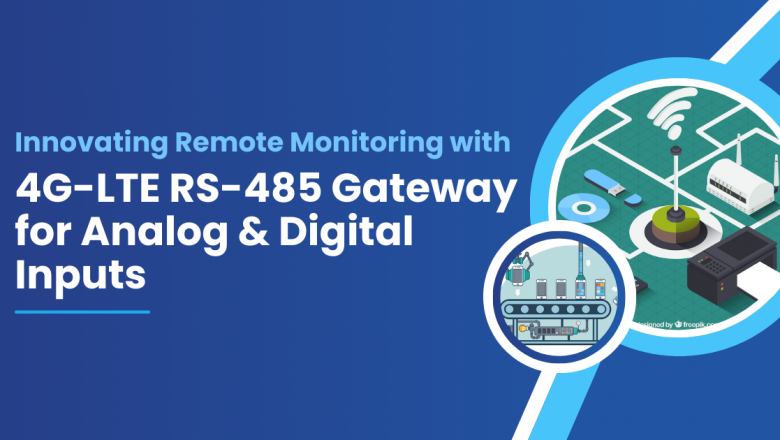views
The growing demand for real-time monitoring and automation in industries has led to advancements in connectivity solutions. One such innovation is the 4G-LTE RS-485 Gateway for Analog & Digital Inputs, a versatile tool that integrates legacy systems with modern monitoring needs. This article explores how this technology transforms remote monitoring and enhances industrial efficiency.
Understanding 4G-LTE RS-485 Gateway Technology
A 4G-LTE RS-485 Gateway is a communication device that bridges analog and digital inputs with a 4G-LTE network, enabling remote data transmission. It integrates RS-485 protocols—common in industrial automation—with cellular connectivity, ensuring reliable and scalable monitoring.
Core Features:
1. Dual Input Support: Simultaneously handles analog and digital inputs.
2. Reliable Connectivity: Leverages 4G-LTE for uninterrupted data transmission.
3. Protocol Integration: Supports Modbus RTU/ASCII for seamless communication with industrial devices.
4. Scalability: Suitable for applications ranging from small systems to extensive industrial operations.
Key Benefits of the 4G-LTE RS-485 Gateway
1. Remote Monitoring
a. Enables real-time data access from remote locations.
b. Minimizes the need for on-site inspections.
2. Seamless Integration
a. Connects legacy systems with IoT platforms.
b. Supports both analog signals and digital outputs, increasing versatility.
3. Cost Efficiency
a. Reduces costs associated with wiring and manual monitoring.
b. Supports energy-efficient protocols, lowering power consumption.
4. Enhanced Data Security
a. Encrypts transmitted data, protecting sensitive industrial information.
b. Provides configurable access control for secure operations.
5. Scalability and Flexibility
a. Expands easily with additional sensors and devices.
b. Adapts to various applications, from manufacturing to agriculture.
Applications of 4G-LTE RS-485 Gateway
This technology is applicable in industries where remote monitoring, automation, and data collection are crucial. Below are some key use cases.
1. Industrial Automation
Factories use the gateway to monitor machines, ensuring operational efficiency and timely maintenance. The RS-485 protocol communicates with programmable logic controllers (PLCs) for smooth automation.
2. Renewable Energy Monitoring
Solar farms and wind turbines use analog inputs for energy output tracking and digital inputs for fault alerts. The 4G-LTE connection ensures centralized monitoring across vast areas.
3. Oil and Gas Industry
Remote pipelines use gateways to detect pressure changes and valve statuses. The 4G-LTE network transmits data even from remote drilling sites.
4. Agriculture
Farmers utilize gateways to monitor soil moisture and weather conditions, ensuring optimal irrigation and crop health.
5. Smart Cities
The technology supports applications such as streetlight control, water management, and building automation by integrating analog sensors and digital actuators.
Technical Specifications of a Typical Gateway
A well-designed 4G-LTE RS-485 Gateway offers the following specifications:
How the Gateway Simplifies Remote Monitoring
1. Data Aggregation
a. Combines inputs from multiple sensors into a single system.
b. Reduces hardware complexity.
2. Real-Time Alerts
a. Sends SMS or email notifications for abnormal conditions.
b. Provides faster response to emergencies.
3. Cloud Integration
a. Uploads data to cloud platforms for advanced analytics.
b. Enables centralized monitoring through dashboards.
Challenges in Adopting 4G-LTE RS-485 Gateways
While the benefits are significant, there are a few challenges:
1. Initial Costs
The cost of hardware, installation, and IoT platform subscriptions can be high.
2. Network Dependency
Remote locations with poor 4G-LTE coverage may face connectivity issues.
3. Compatibility
Integrating legacy equipment may require protocol converters or firmware updates.
Solution: Opt for gateways with multi-network support and backward-compatible features.
Statistics Supporting Remote Monitoring
1. The global IoT gateway market was valued at $1.54 billion in 2020 and is expected to reach $3.45 billion by 2028 at a CAGR of 11%.
2. Studies show that predictive maintenance using remote monitoring reduces equipment downtime by up to 40%.
3. Over 70% of industrial facilities reported improved operational efficiency after adopting IoT-based monitoring systems.
Conclusion
The 4G-LTE RS-485 Gateway for Analog & Digital Inputs is a revolutionary tool for remote monitoring and control. By bridging traditional industrial protocols with modern cellular networks, it enables real-time insights and operational efficiency. Whether for factories, agriculture, or smart cities, this gateway is a vital component of the modern IoT ecosystem. For industries aiming to optimize processes, adopting this technology is a step toward smarter operations.






















Comments
0 comment